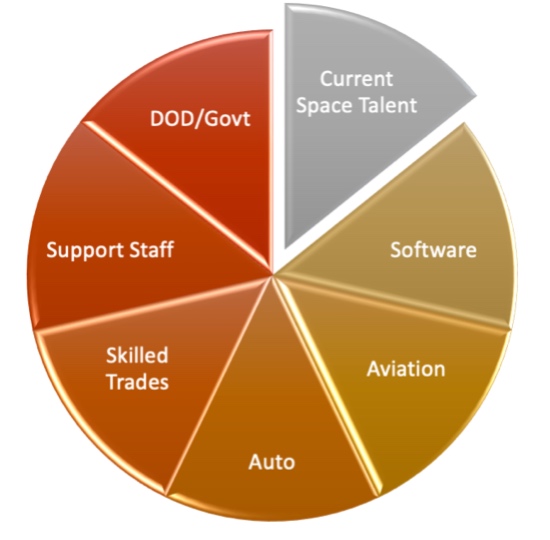
Turnover and retention: an unspoken cost center affecting space companiesby Joseph Horvath
|
| Companies and agencies are all vying for the same, limited piece of the talent pie. Everybody wants a unicorn, regardless of whether they can afford it or even find it. |
In the current environment, smart choices made in hiring and workforce development can aid the capital crunch by supporting affordable talent acquisition, decreasing turnover, motivating employees, and retaining experienced problems solvers. The bottom line is that people are the greatest strength to the space industry, yet overlooked in comparison to technology or systems.
Source. Train. Retain. Upskill. Those four words that should be a mantra of the growing space industry looking to solve the workforce challenge. Yet, companies and agencies are all vying for the same, limited piece of the talent pie. Everybody wants a unicorn, regardless of whether they can afford it or even find it.
Today’s space workforce conditions make reducing turnover and retraining of adjacent industry talent top priorities:
The loss of Boomers is not being met by Millennials or Gen Z because of a few reasons:
What is the true cost of turnover or lack of retention? Studies show that the costs to replace an employee range from one to two times the annual average salary. The average salary for the space industry is $125,000, which equates to $125,000 to $250,000 per employee lost.
This is compounded by the fact that most companies are searching for “unicorns”: people with levels of skill and experience that rarely exist, causing them to focus on a tiny pool of candidates. That is a wonderful position for seasoned space professionals who are open to being poached back and forth across the community, but not a model that can be sustained, or one that adds talent to the industry. The cost in time and resources spent chasing the “perfect hire” is significant. There is a better way.
To expand the talent pool, the space industry should be looking at other industries to find new talent. There exist large groups of untapped talent across the aviation, auto, software and other well-developed industries. This skilled talent in adjacent industries, ripe for a transition to space, brings with them experience and knowledge to help streamline and improve company performance.
 |
The key is providing the necessary outreach, pathways for entry, and baseline training on space operations and astronautics during onboarding. This allows them to quickly add value, enabling them to best communicate within and between teams, understand the organization’s mission and goals, and the needs and requirements of users and customers. Continuous, properly spaced professional development through upskilling creates a long-term pathway of success within the organization.
Regardless of where talent comes from, there is a lack of onboarding and upskill training being offered by companies. One reason for this is that until the past decade, space was largely dominated by government organizations and their supporting prime contractors. It was a largely static industry from a workforce perspective, with a slow, predictable growth rate.
| There exist large groups of untapped talent across the aviation, auto, software and other well-developed industries. This skilled talent in adjacent industries, ripe for a transition to space, brings with them experience and knowledge to help streamline and improve company performance. |
The commercial space boom has changed the environment drastically and requires companies to continuously work to develop and evolve the knowledge and skills of their staff to remain competitive. Organizations that invest in their people will remain at the cutting edge of best practices, technology, policy, law, and other important areas. Simply put, a small investment in training improves communication, performance, creativity, and, most importantly, business outcomes.
The cost of turnover can be significantly reduced through better sourcing models and the addition of professional development within your space company. The best part is that by utilizing this method, simply preventing just one employee from departing pays for an entire year of a training program for the whole company—the return on investment is substantial.
Stop spending time chasing unicorns. Expand your talent pool through more efficient sourcing. Keep your top talent by investing in their future from onboarding and beyond. These are simple measures that reduce overall cost, increase performance, and improve your competitive position. Technology is great, but people are the strength that sets a company apart from the pack over the long term.
Note: we are using a new commenting system, which may require you to create a new account.